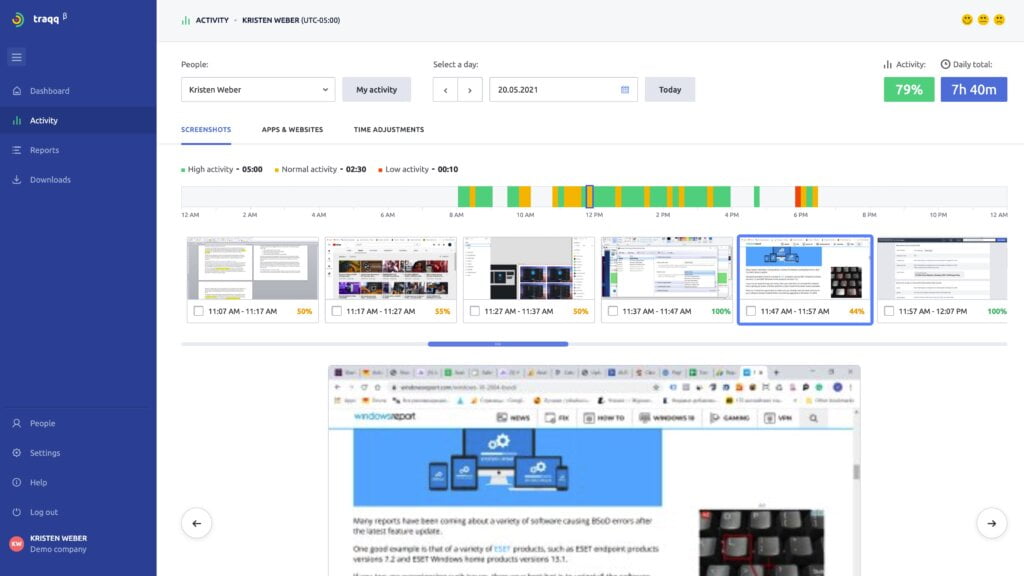
Are you aware of the time you spend on things that do not contribute to your growth and success? Those who strive to be productive may think that they rarely waste time. Well, if you haven’t used an activity log, you’re in for a surprise.
What Is a Daily Work Log?
A job activity log is a record of how you spend your time on particular activities or tasks within a day or week. When you track this information, you gain a better understanding of how you invest your time. After a few days of using an activity diary, you will realize that this method is much better than relying on your memory. The recorded data will tell you if you’re allocating the right time of the day to your most important tasks.
Let’s say you’re most creative and energetic in the morning. In this case, you should schedule cognitive-intensive activities around this time. You must know how to monitor your slump times. This way, you can efficiently schedule easy tasks, like replying to emails or answering phone calls, around these times.
How Do Employees Spend Their Day?
When Salary.com surveyed 3,200 employees, almost two-thirds of respondents admitted to wasting time at work. 39% waste one hour a week on non-work-related activities. Meanwhile, 29% spend up to two hours on non-productive things, and 21% waste up to five hours a week. Now, 3% may seem like a small percentage, but this figure is dedicated to respondents who waste more than ten hours a week in the workplace.

As you can see, a significant percentage of employees waste their time at work. So, how do you know if all your hours go to productive activities? Well, one of the best ways to learn how you spend your day is by maintaining time management logs.
What Are the Benefits of Keeping a Log of Your Work Activities?
Is there real value in using a daily activities tracker? What are the benefits you can get from knowing where your time goes? Here are some of them:
You Get More Time
Of course, you shouldn’t take this literally. After all, we only get 24 hours a day—no more, no less. However, when you get an insight into everything happening in your day, you will discover something interesting. When you feel like there’s too little time for your tasks, the reality is that there’s certainly enough time for them. By checking your activity log, you will see that you lost a few minutes here and there.
You Become More Organized
For many, staying organized in the workplace seems impossible. The truth is that most people who struggle with it lack the proper technique. Let’s say you step into your garage and we ask you to recount all the contents of a random storage bin. Can you do it by memory alone? Of course, it’s so much easier when you have a list ready.
A detailed activity journal will show you where your time goes throughout the day. As a result, it will become easier for you to stay ahead of deadlines and keep appointments. Moreover, you will know if you need to reallocate tasks or resources to ensure consistent productivity.
You Eliminate Common Time Wasters

A Wisconsin School of Business research study reveals that throughout the day, many employees cyber slack and find their way into the deep corners of the Internet. Now, what’s wasting people’s time at work? The same Salary.com survey we mentioned gives an insight into this. 41% of respondents say that they access Facebook during work hours. 37% say that they waste time on LinkedIn, 31% on Yahoo, and 25% on Amazon.com.
Common Time Wasters at Work:
- 41% – Facebook
- 37% – LinkedIn
- 31% – Yahoo
- 25% – Amazon.com
How do you learn what’s wasting your time? Well, maintaining a daily activity log will help you understand how you can maximize your work hours. It will show you how often you neglect an important task in favor of poking around a social networking site. You will come to realize that some fun activities, when excessively done, aren’t so enjoyable anymore. After all, you will discover that you’ve been doing them in lieu of completing your tasks.
You Can Get Proof of Work
With a daily activity log, you’ll have a record of all the things you’ve done throughout the day. You can use it to reference all the tasks you completed. Moreover, the data will serve as proof of your productivity. So, if someone claims that you haven’t turned in a project, you can review your activity log. You can go back to the exact day that you finished the task and submitted it. This way, you’re sparing yourself from having to redo the task. What’s more, you can prove your accountability when the higher-ups perform an audit.
Tips on Efficiently and Accurately Tracking Your Activities
We understand if you want to use an activity log to boost your productivity immediately. However, remember that there is an efficient way to do this. Here are the principles you need to follow when tracking your activities:
- Be Honest – You must be honest about where your time goes. Otherwise, there’s no point in striving to get more done in the workplace. Since you’re the one tracking your activities, you’re not doing anything beneficial for yourself when you lie.
- Be Consistent – A behavioral research study revealed that 96.7% of individuals using food journals were more motivated to eat healthily. However, those who gave up meal tracking after a couple of days failed to reach their goal weight. So, if you want to get a clear picture of your productivity, you need to be consistent with your activity log. Ideally, you should track your time for at least two weeks. Moreover, you should do this under regular work weeks. It shouldn’t be during holidays, office events, or before vacations.
- Be Accurate – If you want your daily activities tracker to be effective, you need to ensure that your data is as detailed and accurate as possible. Instead of using hours, go down to the minute. Ideally, you should record everything you do as soon as you begin your work hours.

Aside from applying these principles, you also need to use the following basic components for tracking daily activities:
- The Time of the Day – When you’re logging your activities, you need to write down a period—for instance, 10 AM-10:15 AM. You can use a timer to break down your tasks.
- The Task/Activity – Go on with your daily activities like usual and write them down. Make sure you always note if you’re switching to a different task.
Pro Tip: Use an Online Activity Tracker
As you can see, maintaining a daily work log can be time-consuming. It’s no wonder why many people abandon it after the first few days. Well, thankfully, there is an easier way to track what you’re doing throughout the day. You can use a free activity log app like Traqq.

This lightweight time tracker is easy to download, install, and use. Click Start on the desktop widget and it will start logging your work hours. It also monitors your activities and shows you a visual representation of where your time goes. Simply go to the dashboard, click Activity on the left pane, then go to the Apps & Websites tab on the right pane. Traqq will show you the tasks that eat up the biggest chunks of your time. There, you will see most of the apps you use and the websites you visit.
At the end of the week or month, you can go to the Reports section to get an overview of your activities. Click the Apps and Websites option on the right pane, then select a period. Once you’ve done that, you will see the programs and sites that you used and visited the most.
Conclusion
Indeed, incorporating a job activity log into your time management routine can boost your efficiency. You get to track your most important resource—time.

